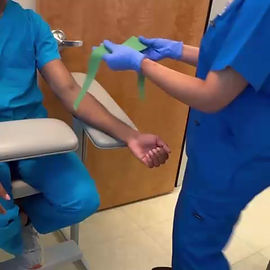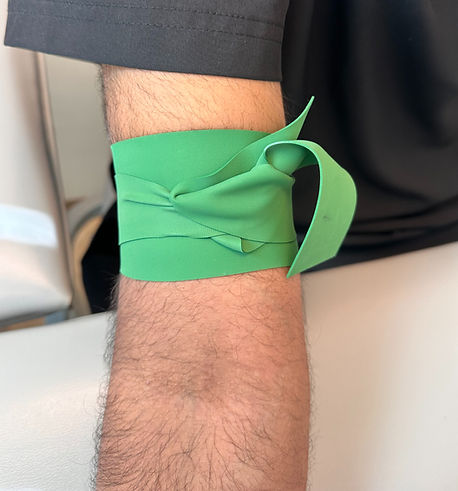
Innovative Solutions

A brand NEW, patented, cutting-edge tourniquet
When the blood pressure cuff
collides with the Tourniquet!

"The TOURNICUFF"



Innovative
Vein Access
The TourniCuff, is a specialized tourniquet for hard/difficult stick patients, designed by a medical professional with over 28 years of experience in the medical field. It is designed to assist Nurses with starting IV's, first Responders and Blood donor technicians. This newly patented device is a versatile tool suitable for various medical settings such as blood donation centers, Plasma centers, urgent care, oncology departments, burn centers, emergency rooms, rest homes and hospitals.
The TourniCuff is an excellent tool for, bariatric patients, geriatric patients, The TourniCuff ensures even pressure, mimicking the functionality of a blood pressure cuff causing full engorgement, dilation and pronouncement of veins for medical professionals to access the veins in a timelier manner.
Apart from its primary function of enhancing vein access, the TourniCuff can also be used to slow down blood flow in critical situations, making it an essential tool in emergency medical care. The TourniCuff can fit snug in your pocketbook, car, or back pack ready you use for critical situations.
_edited_edited.jpg)
Testimonials
As a medical assistant, I found this new invention significantly more effective than a traditional tourniquet. It made locating patients' veins during blood draws much easier and felt more professional and efficient.
Khyati Daggubati
Public Health Major
Our Specialized Tourniquet
The choice of Tourniquets can impact the success of the IV access, blood draws and
patient comfort. It is crucial for Healthcare Professionals to weigh the pros and cons of each type of Tourniquet to provide efficient and safe IV and phlebotomy procedures.
Tourniquet vs. BP Cuff:
While tourniquets are commonly used, research suggests that blood pressure cuffs
are often more effective in dilating veins for IV access and blood draws. A blood pressure cuff inflated to a specific pressure which leads to a larger increase in target vein size compared to a tourniquet pressure.
Many times, a traditional blood draw tourniquet isn't the right tool for the job. This is where the TourniCuff can be used to help. Obesity, for example, often requires a blood pressure cuff so that the patient's circulation in the arm is restricted sufficiently to palpate the available veins of the antecubital area.
In prior versions of the industry's venipuncture standard, Blood pressure cuffs were used in place of a tourniquet. With new redesigning of the traditional blood draw tourniquet mimicking the blood pressure cuff is an incredible breakthrough!!! When the Blood pressure cuff collides with the disposable latex tourniquet brings us the birthing of a NEW WAY to access veins hard difficult veins for IV's and Blood Draws!
Testimonial from a new Nursing graduate:
"During one of my clinicals I was working with a nurse with 25+ years experience and he was awesome. Taught me a lot and inspired me to work in the ED. Something I saw him do was use a BP cuff instead of a tourniquet when starting an IV. He inflated it to the midpoint between the most recent diastolic and systolic reading, saying it was more comfortable, allowed for better blood flow to fill the vein, and said it blew less often on older folks and hard sticks."

_edited.jpg)
Traditional Tourniquet
-
Less adjustable compared to elastic tourniquets
-
Sometimes difficult to remove
-
Applies uneven, tight pressure
-
Can cause bruising of the arm
-
Can cause a skin tears
-
Potential Nerve Damage: Prolonged or excessive pressure from the tourniquet can compress nerves in the arm, potentially leading to pain, numbness, tingling, weakness, or even long-term nerve damage. The radial nerve in the upper arm is particularly susceptible.
-
Can cause pain, swelling, and skin irritation at the application site.
-
In some instances, they may contribute to hematoma formation or even vein damage.
-
In extreme cases, this can even contribute to muscle damage or, rarely, the need for amputation.
-
In some cases, leaving a tourniquet on for too long to find the vein can contribute to the formation of blood clots in deep veins, especially if the patient has pre-existing risk factors.
-
Tight rope feel when searching for a vein
The new patented
TourniCuff
-
A new easy way to tie the tourniquet by securing the band on top of the arm then crossing the straps under the arm bringing the straps on top of the band to tie in place for better comfort and security so that there is no or very little pinching of the patient's arm while accessing the vein
-
25inch to 28inch long
-
8.5 inch wide Cuff with 1"5 inch wide strap
-
Distributes even pressure across the circumference of the arm mimicking a blood pressure cuff effect
-
Makes the veins engorge, more prominent, visible and easy to feel quickly
-
Speeds up the process of locating the vein, reducing the time needed for blood draws and IV access which means fewer needle attempts and blowing of the veins
-
The TourniCuff is more comfortable for the patients
-
Excellent for difficult to stick patients
-
Less or no bruising
-
Excellent for elderly and bariatric patients
-
Excellent for Nurses
-
Excellent for New Phlebotomist
-
Excellent for First Responders
-
Made from high-quality polyisoprene formulation for maximum performance
-
When the Blood pressure Cuff Collides with the Tourniquet! Meet "THE TOURNICUFF"!

Contact Us!
919-798-7238



